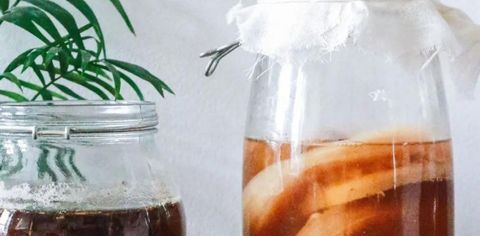
With kombucha having done its due diligence in the world of probiotics, its tastier alternative, Jun, is here to capture the attention of health enthusiasts. Dubbed the ‘champagne of kombucha’, Jun is a naturally effervescent fermented drink made with green tea and raw honey instead of black tea and cane sugar. Jun offers crisper and lighter hint of flavours than that of the traditional kombucha, which has a strong vinegar-like taste. By Eesha Kulkarni
Brimming with health benefits due to the presence of living bacteria, yeasts, organic acids and antioxidants, Jun is brewed by fermenting sweetened tea. The green tea is naturally sweetened with honey and fermented with a symbiotic culture of bacteria and yeast (SCOBY).
History of Jun

With a rich spiritual history dating back thousands of years, the bubbly probiotic tonic is believed to have its roots in ancient Tibetan culture. The history and origin of the drink is based on a folklore claiming Jun to be a sacred elixir that used to be consumed by Himalayan monks to attain spiritual enlightenment. The details regarding its past are obscure at best.
Legend has it that the fizzy, fermented beverage was born out of heirloom cultures passed down from Lao Tzu, the ancient Chinese philosopher and writer of the Tao Te Ching, to the monks of Bon in Tibet for the purpose of energy cleansing.
The absence of modern influence on the remote region of Tibet and the fact that Jun is being brewed by monks even today, furthers the assumptions about its ancient roots. Given that Jun cultures are capable of growing continuously and survive in perpetuity, these heirloom cultures are likely to be in existence for thousands of years.
In spite of the compelling accounts and assumptions of Jun and its history, tracing back to Bon monks, there is little evidence available to support the claims of it being sacred. Whether it be a thousand years old or a renaissance of its sister brew, kombucha, the probiotic drink is a delicious alternative if you have moved on from the kombucha tea bandwagon.
Jun vs Kombucha

Ingredients
The primary difference between Jun and kombucha is the base ingredients. While Jun is made from green tea and raw honey, kombucha uses black tea and refined or cane sugar as its fermentation medium.
Flavour
Jun has a more delicate and subtle taste as compared to kombucha. Its fermentation colonies feed off honey rather than sugar. It is not as acidic as its sister brew. Jun also tends to be fizzier than kombucha. The gut health-boosting tonic is a bit sweet, pleasantly tart and holds less of a vinegary bite than traditional kombucha.
Alcohol Content
The alcohol content in Jun is higher than that of kombucha, owing to the ingredients with which the drinks are cultured. As compared to cane sugar, which contains higher percentages of fructose and glucose, honey has lower amounts of the two. This, coupled with the differences in the strains and yeasts at play, Jun lends a higher alcohol content, which goes up to two percent.
The yeast or SCOBY digests the sugars in the honey, converting it into carbon dioxide and alcohol. The bacteria further processes this mixture into healthy organic acids, enzymes and vitamins to produce a tasty and healthy drink.
Fermentation Time
While kombucha is fermented over a period of 7 to 30 days, Jun requires a shorter window of time to be ready. The latter is fermented in just 3 to 7 days. Another factor involved in the fermentation process is the temperature at which the drinks are brewed. While Jun is cultured at a cool room temperature, kombucha is prepared at a temperature which is 5 to 10 degrees warmer.
How to brew Jun tea

With convincing wellness potential packed in the fermented beverage, health-seekers can brew their own Jun tea at home with just a couple of ingredients. Brewing Jun or kombucha is a two step process consisting of primary and secondary fermentation. The first step is when you make the beverage and the second is when you bottle the tonic to add flavour and carbonation.
In the first step, the SCOBY transforms the honey in the sweet green tea into the slightly sour, tangy and sweet Jun that everyone loves. By the end of this stage, you have a Jun tea, but it may be a little flat and flavourless. This is where the second round of fermentation comes in.
In the second part of this process, you should allow the drink to ferment a little longer in an airtight bottle for 3 to 7 days and can also add flavours like hibiscus, rosemary or basil based on what you prefer. This enables the yeast to naturally carbonate the beverage in an airtight environment.
Recipe

Ingredients
For making this effervescent and mildly sweet and sour beverage, you need 8 cups of filtered and purified water, 2 teaspoons loose-leaf green tea or 2 green tea bags, half a cup of raw honey and 1 Jun SCOBY for the fermentation. Half a cup of previously brewed Jun tea also comes in handy during this process.
Supplies required
You only need airtight brewing jars, cheesecloth and a few fermentation-grade bottles for this recipe.
Instructions
To prepare the green tea and honey, bring the water to approximately 80 degrees celsius in a kettle. In the meantime, spread the loose green tea leaves in a large jar or pitcher. Pour the hot water over the tea and let it simmer and infuse for at least 3 and up to 10 minutes.
Once this is allowed to steep, strain the tea through a fine-mesh sieve into a jar. Steeping is the process of extracting the flavour and health-promoting compounds from the solids used to make tea. Let the concoction cool down to room temperature before you start the brewing process. Add the raw honey to this mixture to give it a slightly sweet flavour with floral notes. Stir till the honey is completely dissolved.
Next, add the SCOBY and its liquid starter, along with half a cup of Jun tea brewed in a previous batch, to the new tea and cover it with cheesecloth or muslin cloth or even a coffee filter. Allow this tonic to ferment for 3 to 5 days or until it gives off a faintly sweet and tart scent.
Once this is done, carefully extract the Jun SCOBY layer and slowly stir the Jun tea. Reserve half a cup of this for your next batch, just like you would do while preparing homemade curd or yoghurt. You can consume the fresh Jun tea immediately, but a second round of fermentation for enhanced carbonation and a deeper flavour profile is recommended. You can store the microbes (SCOBY) and the half cup reserved tea in the refrigerator for up to a week for your next batch.
Secondary fermentation

For the secondary fermentation, stir the finished tea once again and pour it into pint-sized airtight bottles to decant it. At this point, you can optionally add fruits, herbs or juice to jazz it up. Allow this mixture to culture at room temperature for another 1 to 3 days to improve its taste and effervescence. Once done, enjoy the tea as is or with a couple of ice cubes. This tea can be stored in the refrigerator for up to 3 months.
You can watch the recipe on YouTube
Hero and featured image credit: Geraud Pfeiffer/Pexels
Related: Indian Kombucha Brands With The Best Renditions Of The Fermented Tea










